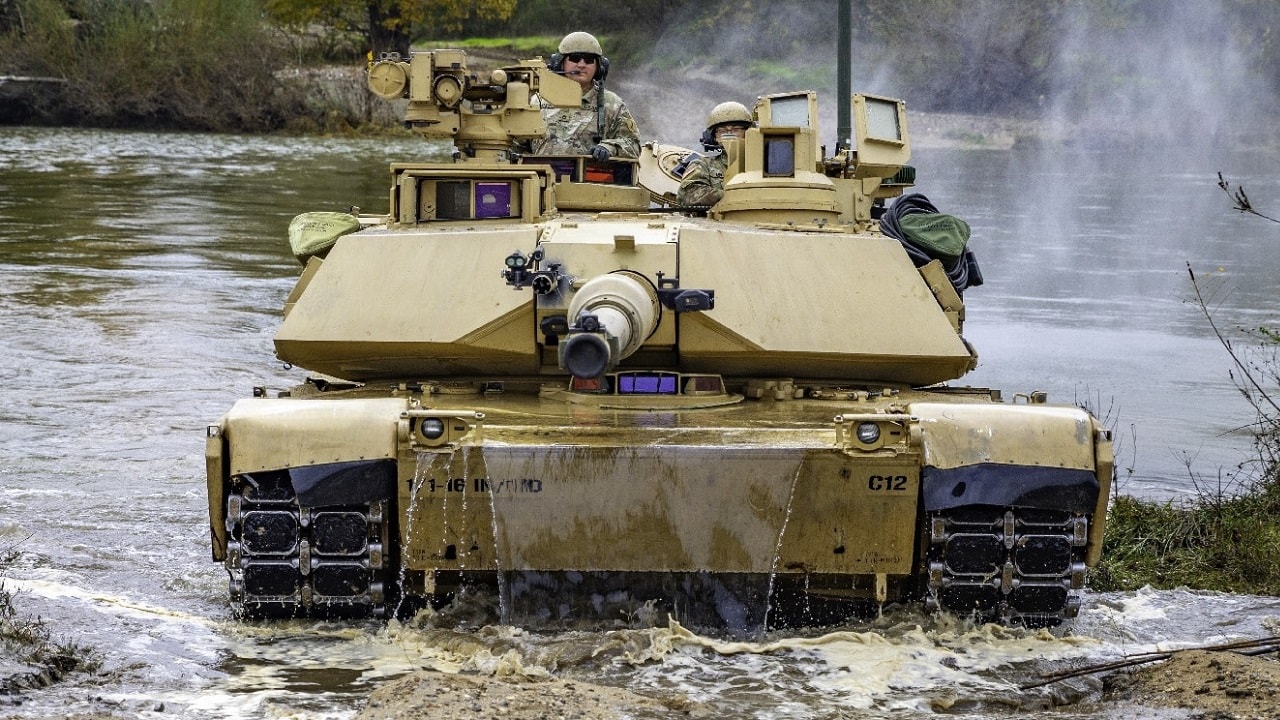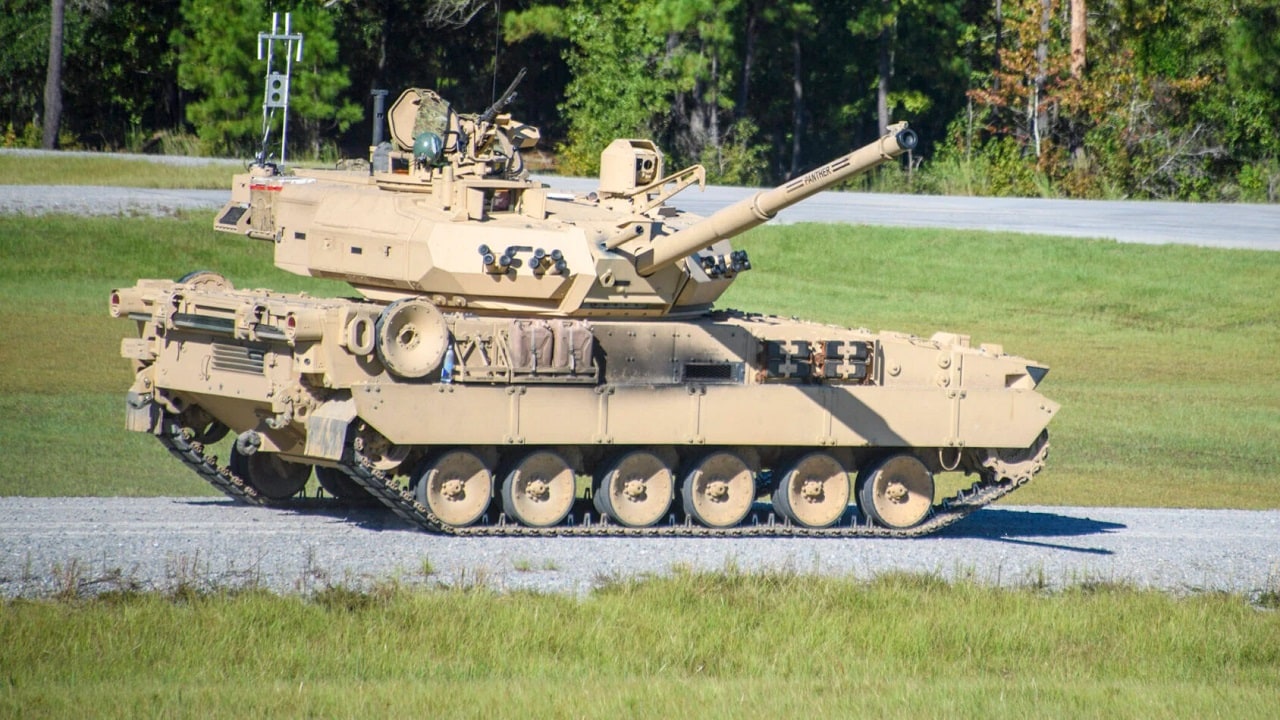The U.S. Army’s M10 Booker, produced by General Dynamics, is the winner of the Mobile Protected Firepower program, which aims to give the U.S. Army a well-protected and mobile direct-fire platform that would operate closely with infantry.
What Is the M10 Booker?
The M10, like the M1, are both formidable armored vehicles that utilize advanced targeting systems to get rounds down range and on-target. Both feature a modern communications suite as well as modular, adaptable armor.
But, the M10 Booker weighs significantly less than the M1 Abrams — around 38 tons to over 70 tons, a curb weight that has steadily increased since the Abrams entered service with the U.S. Army during the Cold War. But although the Booker is outwardly not dissimilar to its larger cousin, the M1 Abrams main battle tank, any physical similarity is superficial.
One of the great advantages the Booker has over its heavier main battle tank counterpart is tactical mobility. It can be transported by air, via cargo plane, more easily than the M1, which affords the Booker a deployment advantage, particularly in austere and rather remote environments in which the heavy Abrams might struggle. Still, there is a rich history of light tanks within the United States.
Light Armor: A Short Primer
The United States Army has long experimented with light tank designs, stretching back to the Second World War. During that conflict, the M24 Chaffee made its combat debut. Though it offered good mobility and firepower, thanks to its 75mm gun, one of its significant drawbacks was its relatively modest armor protection, which proved to be a significant vulnerability against more heavily armed and armored German tanks.
During Vietnam, the United States fielded the M551 Sheridan, a unique and ambitious light tank with a significantly larger 152mm main gun. Designed to fire anti-armor missiles, it proved unreliable in Vietnam’s humid environment. Its armored protection also proved inadequate against dedicated anti-armor weapons.
M10 Booker: Not a Light Tank
Ultimately, both designs underscored the trade-offs inherent in light tanks: trading armor protection and firepower for mobility. Is the M10 Booker, then, in essence, a light tank? The U.S. Army says no.
“The M10 Booker is an armored vehicle that is intended to support our Infantry Brigade Combat Teams by suppressing and destroying fortifications, gun systems and trench routes, and then secondarily providing protection against enemy armored vehicles,” said Major General Glenn Dean, program executive officer of Army Ground Combat Systems said, rejecting the M10’s designation as a light tank.
Instead, the M10 serves as an assault gun, a designation that, generally speaking, is defined by good off-road mobility and a relatively powerful main gun intended to give direct fire support to infantry formations against fortifications and other infantry, with a secondary anti-armor role.
Part of the rationale behind the M10’s decidedly non-tank status is its smaller 105mm main gun. Though long a mainstay of main battle tanks during the Cold War — and still retained by some tanks and artillery pieces — that size main gun has since been eclipsed by the larger 120mm main gun now part of the overwhelming majority of tanks within the NATO alliance.
The Ongoing War in Ukraine
Rumors about a ceasefire and ongoing negotiations aside, the war in Ukraine has highlighted the useful role that smaller armored platforms can still play in a modern war.
Take, for example, the West German-designed Leopard 1. Although an early Cold War-era design, the Leopard 1 has been pressed into service in Ukraine.
Though it would struggle mightily against larger armored vehicles on the Russian side, it nevertheless brings some mass to the fight — mass that Ukraine deeply needs. It’s been locally upgraded as well; in Ukrainian service, Leopard 1s have been outfitted with explosive-reactive armor bricks, slat armor, and anti-drone cages, significantly enhancing the tank’s armor protection.
Alhough less armed and armored than the much larger M1 Abrams (which Ukraine also has in service), it’s proven helpful to Ukrainian defenders.
What Happens Next on the M10 Booker?
Though the United States Army is the intended customer for the M10 Booker, its entry into American service raises the prospect of service with other branches, namely, the United States Marine Corps. As part of the Corps’ Force Design 2030, the guiding document that pivots the U.S. Marine Corps away from the grinding land campaigns in the Middle East and toward a conflict in the Indo-Pacific, they’ve divested all their tanks and tube artillery.
Despite some criticism, the rationale behind the decision, in the case of the Abrams, was that the tank’s enormous weight, which would be logistically difficult to deploy and sustain, would struggle to operate in the unique conditions of the Indo-Pacific.

M1 Abrams Tank. Image Credit: Creative Commons.
However, the usefulness of an assault gun for the infantry-centric Marine Corps is an intriguing prospect. Given the M10 Booker’s relatively lightweight and more modest logistical footprint, the question arises: will the Booker enter service with the Marine Corps?
About the Author: Caleb Larson
Caleb Larson is an American multiformat journalist based in Berlin, Germany. His work covers the intersection of conflict and society, focusing on American foreign policy and European security. He has reported from Germany, Russia, and the United States. Most recently, he covered the war in Ukraine, reporting extensively on the war’s shifting battle lines from Donbas and writing on the war’s civilian and humanitarian toll. Previously, he worked as a Defense Reporter for POLITICO Europe. You can follow his latest work on X.

